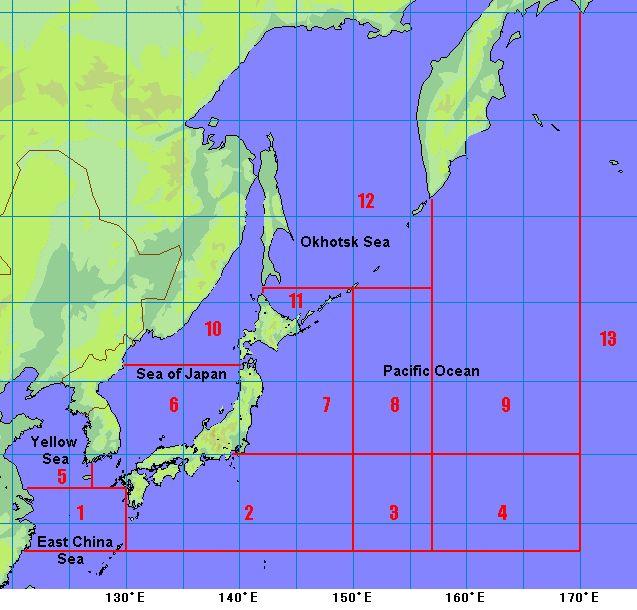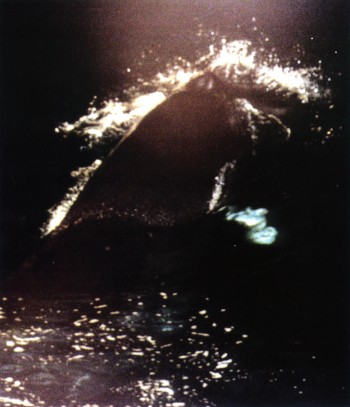
Sub-areas of western North Pacific as established by the IWC.
The research whaling in the western North Pacific (JARPN) started in 1994. The main initiative at first was to make clear the stocks of minke whales in the sea around Japan.
Based on the data obtained through commercial catches of minke whales, two stocks of minke whales had been known as follows,
So the main purpose of the research in the North pacific was to make clear whether there exist sub-stocks in 'J' and 'O' stocks, whether there is 'W' stock, and if so how 'W' stock is mixing with 'O' stock in the western North Pacific. Like the case of research in the Antarctic, lethal methods were employed as well as non-lethal techniques. As a result so far, no evidence was obtained which support the existence of 'W' stock nor sub-stocks in 'J' and 'O' stocks.
The research was done in areas 7, 8, 9 and 11 which were defined by the IWC Scientific Committee, but EEZ (Exclusive Economic Zone) of Russia was excluded from the survey area, and the analysis in area 7 was divided into coastal part 7W and pelagic part 7E. See a table for brief description of the program.

As the research progressed, it became clear minke whales ate various fish
species taken by fishermen, and examination of feeding ecology of minke whales
was recognized as a quite important matter.
Among 498 minke whales taken in the research between 1994 to 1999, contents of forestomach was analyzed on 426 bodies (stomachs of 26 whales were empty and contents of 46 whales were lost for damage by penthrite grenade harpoon), and the results was as follows.
| Number of prey species |
Prey species | 7W | 7E | 8 | 9 | 11 | Total | ||||||
|---|---|---|---|---|---|---|---|---|---|---|---|---|---|
| N | % | N | % | N | % | N | % | N | % | N | % | ||
| 1 | Copepoda | 1 | 0.6 | 1 | 0.2 | ||||||||
| Krill | 7 | 9.2 | 1 | 2.1 | 1 | 1.3 | 7 | 4.3 | 57 | 91.9 | 73 | 17.1 | |
| Japanese anchovy | 44 | 57.9 | 42 | 89.4 | 34 | 44.2 | 61 | 37.2 | 5 | 8.1 | 186 | 43.7 | |
| Pacific saury | 11 | 14.5 | 32 | 41.6 | 70 | 42.7 | 113 | 26.5 | |||||
| Walleye pollock | 8 | 10.5 | 8 | 1.9 | |||||||||
| Japanese pomfret | 1 | 0.6 | 1 | 0.2 | |||||||||
| Salmons | 1 | 2.1 | 1 | 0.6 | 2 | 0.5 | |||||||
| Barracudas | 1 | 0.6 | 1 | 0.2 | |||||||||
| Total | 70 | 92.1 | 44 | 93.6 | 67 | 87.0 | 142 | 86.6 | 62 | 100.0 | 385 | 90.4 | |
| 2 | Krill + Japanese anchovy | 1 | 2.1 | 1 | 0.2 | ||||||||
| Krill + Pacific saury | 1 | 1.3 | 1 | 2.1 | 1 | 1.3 | 6 | 3.7 | 9 | 2.1 | |||
| Krill + Walleye pollock | 1 | 1.3 | 1 | 0.2 | |||||||||
| Krill + Salmons | 1 | 0.6 | 1 | 0.2 | |||||||||
| Krill + Barracudas | 1 | 0.6 | 1 | 0.2 | |||||||||
| Japanese anchovy + Japanese pilchard | 4 | 2.4 | 4 | 0.9 | |||||||||
| Japanese anchovy + Pacific saury | 2 | 2.6 | 2 | 1.2 | 4 | 0.9 | |||||||
| Japanese anchovy + Walleye pollock | 1 | 1.3 | 1 | 0.2 | |||||||||
| Japanese anchovy + Salmons | 1 | 2.1 | 2 | 2.6 | 3 | 0.7 | |||||||
| Chub mackerel + Japanese pilchard | 1 | 1.3 | 1 | 0.2 | |||||||||
| Pacific saury + Japanese pomfret | 1 | 1.3 | 1 | 0.6 | 2 | 0.5 | |||||||
| Pacific saury + Walleye pollock | 0 | 0.0 | |||||||||||
| Pacific saury + Chub mackerel | 1 | 1.3 | 1 | 0.2 | |||||||||
| Pacific saury + Salmons | 2 | 2.6 | 3 | 1.8 | 5 | 1.2 | |||||||
| Pacific saury + Barracudas | 1 | 0.6 | 1 | 0.2 | |||||||||
| Pacific saury + Squids | 1 | 1.3 | 1 | 0.2 | |||||||||
| Total | 5 | 6.6 | 3 | 6.4 | 9 | 11.7 | 19 | 11.6 | 0 | 0.0 | 36 | 8.5 | |
| 3 | Krill + Pacific saury + Salmons | 2 | 1.2 | 2 | 0.5 | ||||||||
| Krill + Pacific saury + Squids | 1 | 1.3 | 1 | 0.2 | |||||||||
| Japanese anchovy + Pacific saury + Squids | 1 | 1.3 | 1 | 0.2 | |||||||||
| Pacific saury + Japanese pomfret + Salmons | 1 | 0.6 | 1 | 0.2 | |||||||||
| Total | 1 | 1.3 | 0 | 0.0 | 1 | 1.3 | 3 | 1.8 | 0 | 0.0 | 5 | 1.2 | |
| No. whales observed | 76 | 100.0 | 47 | 100.0 | 77 | 100.0 | 164 | 100.0 | 62 | 100.0 | 426 | 100.0 | |
The summary on the prey of minke whales by JARPN survey is as follows.
"... In the Pacific side, Japanese anchovy was the most important prey species in May and June, while Pacific saury was the most important one in July and August. Krill was the most important prey species in September. Walleye pollock was also an important prey species during June and September in coastal waters, over the continental shelf. In the southern Okhotsk Sea, krill was the most important prey species in July and August. These changes in the prey species of minke whales probably reflect changes in the availability of prey species in these areas.","... In the western North Pacific minke whales are opportunistic feeders with a broad diet and with flexible feeding habits."
(from "Geographical and seasonal changes of prey species in the western North Pacific minke whale", Tsutomu Tamura and Yoshihiro Fujise, IWC/SC/F2K/J22, 2000)
In the situation that FAO (Food and Agriculture Organization) of U.N. recommends to reduce human fishery activities, there are cetaceans which are protected regardless of stock status, and a study about 35 species of cetaceans (out of over 80 species in total) showed amount of marine resources consumed by those 35 species were 3 to 6 times of that taken by human (T. Tamura, S. Ohsumi, 1999). In the sea round Japan, it is estimated even minke whale only consumes Pacific sauries of 10 - 20% of catch by Japanese fisheries.
In the northern hemisphere, minke whale is the smallest baleen whale species, and there are stocks of relatively abundant larger whale species around Japan, i.e. Bryde's whales whose estimated population is 23,000 (IWC 1996), and sperm whales which is estimated to be 107,000. Because of their larger biomass, they are much more influential to fish and fishery around Japan, and the research program was extended in 2000 as JARPN II which also takes 50 Bryde's whales and 10 sperm whales. A troll ship was newly added to the research fleet to study about prey fish species.
Although the U.S. government pressures Japan that sperm whale is a endangered species by its classification, its estimated population in the whole world is over one million, and there are over 100,000 even in Japan's research area. This claim by the U.S. government is in contrast to the fact that they removed the Pacific grey whales of estimated population of about 26,000 from a list of endangered species. It seems U.S. government has quite unique criteria about which whale species is endangered, i.e. the criteria which cannot be understood by common sense. The base of politics of anti-whaling nations is far from scientific facts.

_